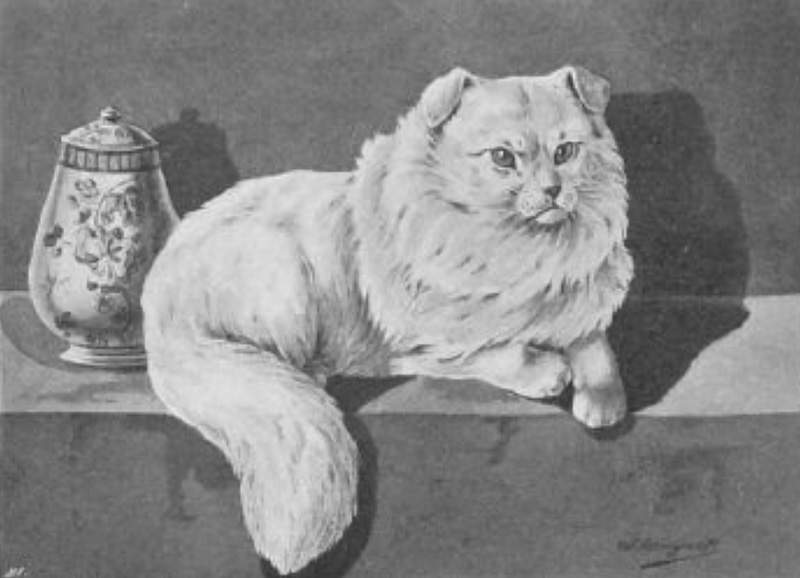I have been scratching my head trying to figure out how to write about this so-called cat breed discovered in China and first described by a Polish Jesuit missionary Michael Boym in his book Flora Sinensis (1656). The best source of information about this cat breed is Sarah Hartwell and I would happily refer people to go to her webpage if you want to trawl through the tortuous story about the misdescription, misunderstanding, mistranslations and mistakes and confusion regarding this so-called breed. It all starts with the name Sumxu, which apparently, according to Hartwell, is the Portuguese rendering of ‘songshu” meaning pine rat! Nothing to do with a cat but the name stuck as describing an ancient and mysterious Chinese cat breed nonetheless.

Even Charles Darwin himself picked up information about the so-called breed and referred to a droopy-eared race of cats in China. He mentioned the cat in his book “Variation of Animals and Plants under Domestication”. Sarah Hartwell describes how the misconceptions were passed from one expert to another:
“Buffon’s source was Prevot, whose source was Green, whose source was de Halde, whose source was Martini’s 1655 work.”
This seems to sum up what I would describe as a mess and mass of inaccuracies. Today we don’t know whether the Chinese Lop-Eared Cat was a genuine cat or a marten or another animal.
On my reading of Sarah Hartwell’s article, it appears to me that this cat breed had “lop-ears” because they carry the same gene as the Scottish Fold which as we know today causes the ears to lie flat to the head or halfway to that state. It depends on how the gene affects the cartilage in the ear flap as to whether the ears lie flat to the head or simply flop over as we see in the illustration on this page.
The reports refer to the Chinese Lop as having “pendulous ears” which conjures up images of the ears of a Labrador dog but I think we have to say that that description was inaccurate and an exaggeration. You know how it how goes when information is passed down the line and it gradually changes and sometimes becomes exaggerated particularly when people enjoy discussing a mysterious animal. Hartwell admits that it probably had ears that folded like the Scottish Fold.
It is said that the ladies of China particularly liked this cat. It was a lap cat. It is suggested that the cat was a lap cat because it had difficulty in moving due to the nasty and debilitating additional effects of the presence of the gene which causes the ears to fold over. This affects the cartilage in the feet and in other parts of the body which are crippling.
The history of this breed also describes it being used for meat production. It was a cat bread to be eaten. This comes from a German book published in Berlin in 1896 called Illustriertes Katzenbuch. It states “The poor creatures locked up in small bamboo cages and much like a kind of geese fattened with plentiful portions”. The author said that the cat was “regarded as special titbits and enjoyed particularly with chains (noodles?), with rice”.
The cat was also described as having poor hearing. The author speculated this was because the cat no longer needed to use their ears being locked up in cages all their lives and eaten at the end of it. But Sarah Hartwell speculates that if the cats were white, they might have been deaf because there is a high prevalence of deafness in white cats. This is because the dominant white gene affects the colour of the hair, the colour of the eyes in removing pigmentation, and the inner ear.
We are told that the last reported sighting of the Chinese Lop appears to have been in 1938. This is when one was imported from China into England I believe. It was thought at the time that the mutation which produced the appearance of this cat was restricted to white longhaired cats.
It is unclear to this day whether the Chinese Lop was a genuine race of interesting domestic cat or whether the trait which gave it its particular appearance was inherited. And we don’t know the exact “conformation” i.e. appearance of the cat. But sensibly, Sarah Hartwell decided that “the general type is probably represented by the Scottish Fold and its derivative breeds”. In other words, this was probably a Chinese version of a white, medium-longhaired Scottish Fold.
Some experts at the time even suggested that the animal might be a hybrid between a cat and a marten (Gaston Percheron in “The Cat: Natural History, Husbandry [“Hygiene”] and Illnesses” 1885). And another Georges Louis Leclerc, Comte de Buffon, stated that the climate of Pe-chi-ly in China resulted in cats having long hair and pendulous ears which were the favourites of ladies (a very tenuous connection). I just see lots of confusion in the story and lots of descriptions by different people but a complete lack of clarity as to what this animal was.

